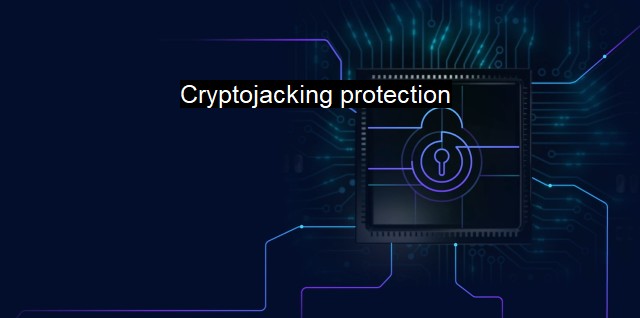What is Cryptojacking protection?
Cryptojacking: The Emerging Cybersecurity Threat to Businesses and Individuals Investing in Cryptocurrencies
Cryptojacking protection is rapidly emerging as one of the crucial aspects in the wider cybersecurity landscape, and the domain of antivirus services, owing to the exponential growth in crypto-related threats. For the comprehension of the term, it is integral to first understand the concept of cryptojacking.Cryptojacking refers to the unauthorized use of an individual’s or an organization's computer resources to mine cryptocurrency. The hacker uses a piece of malicious software, which gets downloaded on the victim's computer without their knowledge, either via a malicious link or through a website running the script, to mine the digital currency. This exploitation attributes not only to the slowdown of systems but also to data theft, including sensitive financial details, without the user realizing it.
Cryptojacking protection, therefore, involves imbibing measures to detect and prevent cryptojacking attempts on one's digital infrastructure. This prevention is possible in various ways, such as through the employment of robust cybersecurity infrastructure, user awareness programs, and advanced antivirus systems specializing in Cryptojacking protection.
A compelling cybersecurity infrastructure comprises several features. One of these features includes traffic monitoring systems that can detect any unusual or excessive use of resources or suspicious outbound network traffic, indicating possible mining activity. Cybersecurity technology equipped with machine learning and artificial intelligence can adapt to identify newly evolved threats and even predict potential attacks.
Apart from hardware and software measures, user awareness plays a crucial role in preventing cryptojacking attacks. Training employees to discern phishing emails, malicious links, and risky websites can help nip cryptojacking attempts in the bud. Also, keeping software and computer systems updated is equally vital as hackers often exploit vulnerabilities in outdated systems for cryptojacking.
In addition to cybersecurity best practices, the utilization of antivirus services designed to block cryptojacking threats is a proactive step in cryptojacking protection. These antivirus services offer real-time protection, regularly updating their virus definitions to arm your computer against the most current threats, which now very much includes cryptojacking. They identify possible infected files and websites, alerting the user about them, even before they are clicked or downloaded.
At the most granular level, several detailed user habits can help reduce the risk of cryptojacking. Regularly updating systems, using strong, unique passwords, regularly checking for any unusual sudden changes in device performance, taking caution with email attachments or links from unknown senders, regularly backing up critical data, and using encrypted online connections can significantly reduce the risk of exposure to cryptojacking and other cyber threats.
The increasing monetization through cryptocurrencies has made cryptojacking a financially attractive prospect for cybercriminals globally. Therefore, having cryptojacking protection becomes all the more important in today's digital world. From the business perspective, cryptojacking poses not only a threat to individual systems and sensitive user data but also to revenue and reputation. A cloaked operation like cryptojacking, done for extended periods, can extract significant financial value, severely hampering organizations' operations and their relationships with clients.
To sum, cryptojacking protection broadly envelopes maintaining robust cybersecurity infrastructure, regular system updates, stringent browsing habits, adoption of fortified antivirus systems, and prioritizing user training and awareness. By imbibing these robust security practices and behaviors, one is equipped not just to nullify cryptojacking attempts but also ensure the general safety of digital assets and contribute to the broader cybersecurity infrastructure. As the realm of cyber threats continues to evolve in sophistication and complexity, relentless upgradation and timely interventions will remain paramount in protecting individual netizens and organizations from the likes of cryptojacking.

Cryptojacking protection FAQs
What is cryptojacking and why do I need protection against it?
Cryptojacking is a type of cyber attack in which the attacker uses your computer resources to mine cryptocurrency without your consent. It can slow down your computer, decrease its lifespan and increase your electricity bill. Protection against it is important because it can compromise your privacy and security.How can I protect my computer from cryptojacking?
You can protect your computer from cryptojacking by using antivirus software that has anti-cryptojacking features, such as Real-Time Protection, which detects and blocks cryptojacking attempts as they happen. You can also use browser extensions that block cryptojacking scripts or limit the processing power that can be used by websites.What are some signs that my computer has been cryptojacked?
Some signs that your computer has been cryptojacked include a sudden slowdown in performance, increased CPU usage, strange noises coming from your computer, and increased electricity bills. If you suspect that your computer has been cryptojacked, you should scan it with antivirus software and remove any malicious programs or scripts.Can cryptojacking cause permanent damage to my computer?
Cryptojacking itself cannot cause permanent damage to your computer, but it can decrease its lifespan and cause hardware failure due to the increased workload on CPU and GPU components. Additionally, cryptojacking can lead to other types of malware infections or data breaches, which can potentially cause permanent damage to your computer and compromise your privacy and security.| | A | | | B | | | C | | | D | | | E | | | F | | | G | | | H | | | I | | | J | | | K | | | L | | | M | |
| | N | | | O | | | P | | | Q | | | R | | | S | | | T | | | U | | | V | | | W | | | X | | | Y | | | Z | |
| | 1 | | | 2 | | | 3 | | | 4 | | | 7 | | | 8 | | |||||||